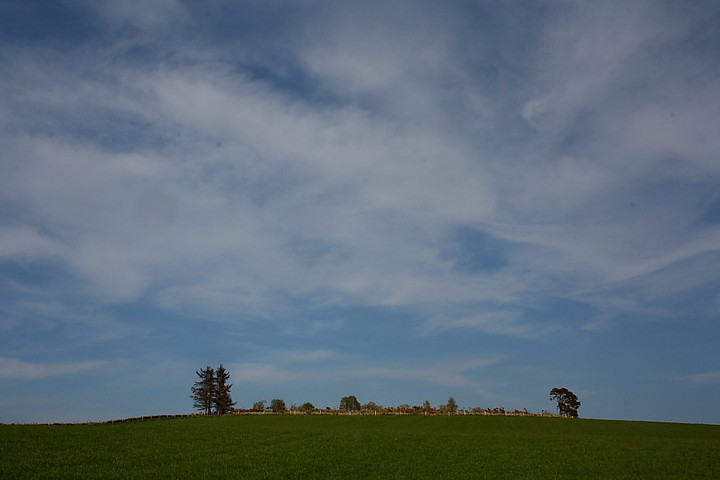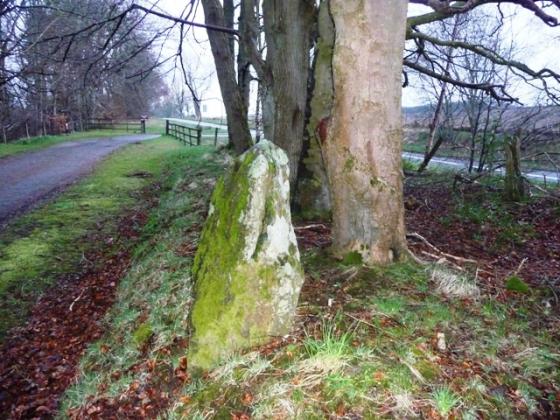
Fallen NW Stone of Candle Hill Stone Circle hidden in gorse.

Fallen NW Stone of Candle Hill Stone Circle hidden in gorse.

Cup Carving on Fallen E Flanker of S Recumbent Stone of Candle Hill Stone Circle.

Candle Hill Stone Circle viewed from S.

NNE Standing Stone (Candle Stone) of Candle Hill Stone Circle viewed from S.



Recumbent.....

Look closely, and that’s Dunnideer framed between the trees. And another ‘hill’ beyond. That one’s famous, too. Apparently.

Recumbent and flanker.

The recumbent is about as ‘recumbent’ as it can get. But, hey.

Just the one orthostat... but that’ll do for me.


Candle Hill.... you wouldn’t know it, but there’s a shattered RSC up there. And so much vibe you couldn’t cram any more in with a crow-bar

view over recumbent to Hill Of Christ’s Kirk

possible cup mark on east flanker

west flanker

The view towards Dunnideer Hill and Bennachie beyond the prostrate recumbent and flanker stones of Candle Hill Stone Circle.

This is a panoramic composite photo showing Candle Hill Stone Circle (Insch). The prostrate recumbent and flankers, the central mound, one stone on the western arc and the northern upright stone are all clearly visible.









The only stone left standing.

The view over the recumbent from inside the circle.

The fallen recumbent and flankers, looking W.

The circle

The view towards Dunnideer

The sorry state of Candle Hill, circa August 2000 CE.
Visited 20.09.19
It is difficult to access Candle Hill Stone Circle: It is protected by an enclosure and vigorous shrubs. It is best to enter the enclosure on the SE corner adjacent to the remains of the circle. The circle is located c. 30 yards ESE of the centre of the knoll. The most obvious feature is the Candle Stone, a standing stone c. 15 feet W of a thorn tree. A grassy cairn is situated c. 6 feet S in the centre of the circle. Walk S round the cairn to reach the fallen recumbent stone and flankers on the S Arc of the circle. It is possible to find the fallen N,ENE,W and NW stones by walking round the perimeter of the circle, starting from the NNE Standing Stone. The N,ENE,W stones are largely buried in the turf with only a small area visible from above. The NW stone is hidden in gorse on the NW Arc.
Loved this.... an utterly trashed site, yet endowed with such a vibe I doubt if you could squeeze any more atmosphere in with the proverbial crow bar. Yeah, just the one orthostat remains erect from the ring enclosing the green cairn.... presumably funerary in nature. But it is more than enough, to be honest, thanks to the natural aesthetic beauty of its fallen companions, not to mention distant hills. Of the former, none are more exquisite than the recumbent – has ever there been a more ‘recumbent’ recumbent? – and attending flankers.
Again, the fabulous, full on light no doubt has a great positive bearing upon the visit, highlighting colour and texture of stone to great effect. However I’ve a feeling a visit in pouring rain would be far from a washout upon Candle Hill... hey, some sites have simply ‘got it’, others haven’t. Difficult to define, I guess. You just ‘know’ when you arrive there.
As mentioned, despite being collapsed, the recumbent and flankers remain – for me – the focal point of the monument. A light covering of lichen and moss enhance form, Dunnideer and Bennachie taking care of the horizon.... as you would expect. However all is not rosy in Candle Hill’s garden, the view of Tap O’Noth having to be made across a gulley filled with rusting cars and other assorted junk. Yeah, Candle Hill doubles as a dumping ground, much to the shame of the landowner.
Which brings me to the question of access. Who owns Candle Hill? Hmm. Upon arrival I find the metal field gate secured with barbed-wire. Not very nice, it has to be said. I therefore make for the nearest house (Coldhome) and ask permission, only to be informed that the hill is not the property of the occupants.... and they have no idea to whom it does belong. Consequently I assume ‘they’ – whoever ‘they’ are – will not mind. Well, it wouldn’t do to miss out on an audience with Candle Hill, would it?
April 27, 2011
I set off to visit Candle Hill on a brilliant day of cloudless sunshine. If the site were as bad as some of the reports below suggest, then at least the views towards Bennachie and Dunnideer Hill should be worth seeing. I can only say that I was most pleasantly surprised. There seems to have been recent activity removing the worst of the gorse from the hill and the site of the stone circle was reached with ease.
My second surprise was that the circle is almost complete – though all but one of the stones are prostrate. My first sighting was from the north, of the single standing stone, and the prostrate recumbent and flankers beyond. But from the west flanker, four large stones marked out the western arc of the circle. Only the 3rd stone was prominent; the other three were covered with moss and other vegetation and almost completely buried: they stood only a couple of centimetres proud of the ground. Then came the upright stone, and beyond it another large earthfast stone, again, only just breaking the surface. Finally, there was an obvious ‘absentee’ between this and the east flanker.
So there are nine stones still visible, and in place (eight prostrate), with only one member of an assumed 10-stone circle actually missing.
Because of the large central mound, it is not possible to see all the stones in context. An aerial close-up from a helicopter would be illuminating and show the true nature of the circle.
A good day out, with much more to see than I ever imagined. My photograph is a panorama, showing clearly the recumbent and flankers, the central mound, and the upright northern stone.
Access: There is now a gate in the wall surrounding the hilltop. From the road, make uphill towards the prominent lone Scots Pine tree, follow the wall for a few yards to the right, and you are there. Through the gate, keep following the wall and you will see the large upright stone after 50 yards or so.
You can avoid the worst of this site by not entering the gorse-covered enclosure right away and following the field wall clockwise (assuming you have approached from the S) until it straightens out close to where the remains of the circle are visible.
It doesn’t make the circle any more interesting though.
Visited 18 October 2005
we arrived at the place and people said it was not worth visiting – i wish I had had a quick look now!
August 2001
As gyrus mentioned, Candle Hill is degraded with the rubbish dump nearby but enough of the site remains to give an impression of the former grandeur of the circle. It is so remote and yet so connected to the larger ritual picture of the area. Yes, the stones have all fallen (except one) but there is still an aura there – I love it.
A sad, fallen place. Anticipated a great view from here, a site situated on the crest of a hill. The summit is overgrown with trees and bushes, surrounded by a 4ft wall. Trying to mount it from the west, I was confronted by some rotting animal knuckles covered in flies. After finding my way through the dense gorse, I was confronted with a truly ugly site – dumped in a large gash in the summit was a huge pile of garbage and – wait for it – rusting car wrecks! At least three remains of cars, with washing machines and other trash. How did they get it up here? Very strange.
Anyway, the circle itself is severely degraded, unsurprisingly. There’s a rounded, fallen recumbent with fallen flankers. The stone opposing the recumbent is the only one left standing, a fine chest-height wedge. Two other fallen stones.
A curious feature here is the raised cairn-like mound in the centre of the circle – has this been excavated? Another added-on burial, as at Loanhead of Daviot?
No view from here – I was glad to get away from it, a forlorn place of dead trees, trash and lethargic insects.
Love them bees!
“The Candle Stone is a large pillar-stone which stands at Candle Ridge, Drumwhindle,
near Arnage, and there are three Candle Sills, one at Oyne, one in the parish of Rayne, and the other near Insch, within a few miles of each other. On each of these Candle Hills there are remains of a stone circle, so that al these candle-names appear to be associated with either stone circles or a standing-stone. The association has given rise to the idea that candles were employed in the ceremonies performed by the “Druids” at such places; but Professor Watson tells me that the Gaelic word signifies not a diminutive candle, but even a huge torch, so that the word might well be applied figuratively to a tall stone suggesting the shape of a torch.
Another explanation of the name, however, is possible. In former days wax candles were much used in Church services, and since the wax was derived from bees, whose honey was used for sweetening, it was not overplentiful, and was accordingly highly valued. Thus gifts of wax frequently find mention in old deeds arid charters : two stones of wax were dedicated in 1233 by the Earl of Buchan to the Chapel of the Blessed Virgin at Rattray, and another grant of 5pounds is referred to in the
confirmation of a charter of John Lord of the Isles in 1460. Grants of wax for Church use came to be associated with land suitable for beekeeping : thus the Candlelands at Ellon were dedicated to the use of the church there, and had to provide twenty-four wax candles three times a year to burn before the high altar of the Church of Ellon. These Candlelands are only some 5 miles distant from the Candlestone and Candle Ridge of Drumwhindle. It may be no more than a coincidence that the Candle Ridge near Ellon and the three Candle Hills in the Insch district have each a standing-stone or a stone circle. Naturally hill-top monuments would escape much of the destruction which visited similar monuments on arable land, so that out of the large numbers of these monuments which must have existed at one time, the hill-top examples stood every chance of survival; further, the very conditions which would account for the preservation of the stones, rough, rather high ground with abundance of heather and the characteristic vegetation of such places, would be just those best suited for the keeping of the bee-stocks which were to produce the sacred candle wax. The suggestion, therefore, is that the ancient stones have only a casual connection with candlelands from which beeswax was obtained or levied”.
Source
Folklore of the Aberdeen Stone Circles and Standing Stones by James Ritchie
Proceedings of The Society of Antquities of Scotland. Vol LX.20
May 10 1926

































































































































































































































